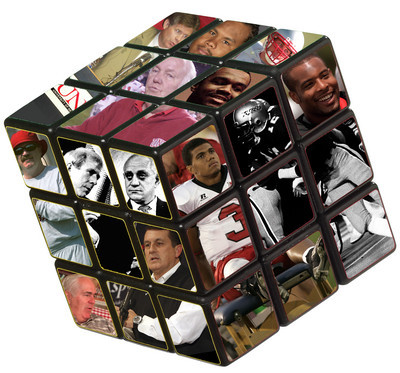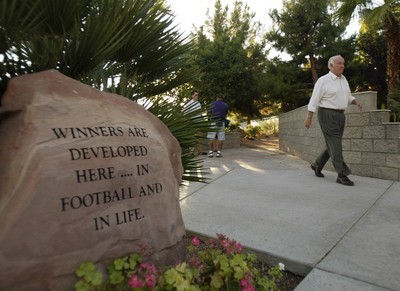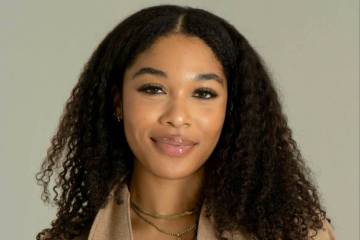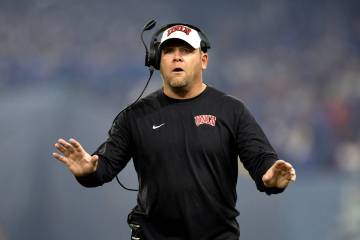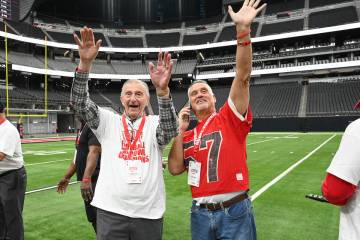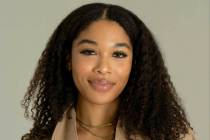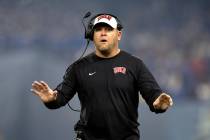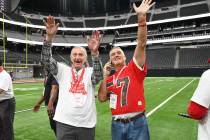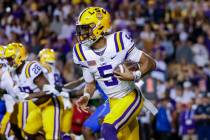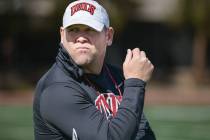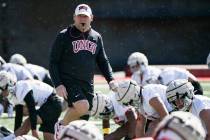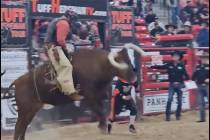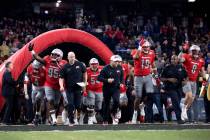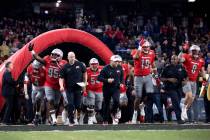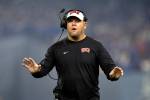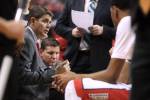Is there any solution for UNLV football?
All of the interceptions, all of the personal fouls, all of the losses over two long decades of futility make it difficult to believe UNLV once had a successful football program.
Yes, there was a time when the Rebels and their fans actually expected to win on Saturdays. Those were the days of Mike Thomas and Randall Cunningham and Marlon Beavers, back before the multitude of defeats.
Coaches Bill Ireland, Ron Meyer, Tony Knap and Harvey Hyde -- the men who developed and nurtured UNLV football in its early existence -- combined for just two losing seasons in the program's first 18 years.
Then Hyde was fired after the 1985 season, and UNLV football hasn't been the same. Not even close.
The subsequent 22 years have produced four winning seasons, including a painful 2-10 record in 2007, which followed two-win seasons in 2006, and 2005, and 2004.
Then-athletic director Brad Rothermel, now special adviser to current AD Mike Hamrick, said former school president Robert Maxson wanted to fire Hyde because of the coach's friendship with Myron Tarkanian, brother of UNLV's legendary basketball coach and Maxson's campus nemesis, Jerry Tarkanian.
"When President Maxson discovered (that friendship), he did what he could to level the legs of the football program," Rothermel said. "We didn't recover from that."
Attempts to reach Maxson, now president at Sierra Nevada College, were unsuccessful. A spokeswoman said via e-mail that Maxson was traveling and unavailable for comment.
Hyde did have off-field issues, though. The Big West Conference refused to count the Rebels' 11 victories in 1984 because of the use of ineligible players, though the wins were not stricken from the NCAA and UNLV records.
But when Hyde left, so did the days of consistent winning. UNLV has tried many times over the years to re-establish itself, only to fall back into an abyss of failure.
In 1994 under first-year coach Jeff Horton, UNLV went 7-5, tied for first in the Big West and trounced Central Michigan in the Las Vegas Bowl. Horton, however, failed to capitalize on that success, winning only six games over the following four seasons.
Horton was replaced by former Southern California and Los Angeles Rams coach John Robinson after the 1998 season. Robinson had the program on track in his second season when that 2000 team went 8-5 and routed Arkansas in the Las Vegas Bowl. But that success didn't last either.
Quarterback Jason Thomas, who played his way into becoming a Heisman Trophy candidate, underwent shoulder surgery the following spring, and UNLV gave away a sure victory in the 2001 opener at Arkansas, a loss that shook the Rebels.
UNLV finished .500 once and had three losing seasons in Robinson's final four years, including a 2-9 record in 2004.
His replacement, current coach Mike Sanford, has been stuck on two victories in each of his three seasons.
FINANCIAL SUPPORT
Coaches came and went, but UNLV's checkbook rarely opened. The annual football budget was about $2.5 million since Hyde ran the program through Horton's tenure -- a span of four coaches. "We did it with a little budget and masking tape," Hyde, who hosts a local radio show, said of building the program.
UNLV made a stronger financial commitment when it hired Robinson, taking such steps as refurbishing Sam Boyd Stadium, building a new press box and making over the practice fields on campus.
The football budget rose 23.5 percent in Robinson's first year to $3.1 million. He was paid $350,000, compared to Horton's $125,000 salary. Robinson's staff was paid $616,651, Horton's $468,130.
Those increases allowed the Rebels to catch up with the fledgling Mountain West Conference norm in terms of their financial commitment to football, but not move to the head of the class.
Hamrick has raised the commitment for Sanford, spending about $6 million on salaries, recruiting trips and facility upkeep, as well as many other incidentals that are part of running a football program. Two-time defending conference champion Brigham Young spends more than $9 million.
"Tell me what you spend it on," Hamrick said of adding more dollars. "You can't spend it on any more scholarships. We can't add any more assistant coaches because the NCAA says you can have only these many assistant coaches. You can't spend any more on recruiting because wherever our assistant coaches want to go recruit, they go recruit."
Sanford wouldn't use the budget as an excuse for the program's failures on the field, but acknowledged that improvements are necessary.
"Would I like to have a refurbished locker room, a new football facility, a new academic building? Yes," Sanford said. "But I believe that everything that we need to be successful this year, right now in 2008, is in place.
"Now can we improve? Yes. Should we always be trying to improve? Yes. Should we always try to be the best? Yes. Do we want to improve our facilities for recruiting purposes? Yes."
LOSING CULTURE
Sanford has long said this is among his greatest challenges, trying to find ways for players to believe they can make plays in key moments of close games.
So he mostly recruited and signed players from winning high school and junior college programs, believing their collective success would instill the entire program with renewed confidence.
But Sanford also has to convince three- and four-star players to be part of the revival effort at UNLV.
Those who choose UNLV are confronted with a toxic mixture of skepticism and apathy from friends, fellow students and those they meet in the community.
"You get people that make comments," wide receiver Casey Flair said. "We dug our own hole a little bit, so it's one of those things you've got to swallow your pride."
Winning, of course, changes attitudes.
"I just know that the way this town is, you win and they'll come," Sanford said.
HEAD COACHES
UNLV has made easy-to-defend hires, but each head coach also had easy-to-see weaknesses.
Rothermel said he was told by Maxson to hire Wayne Nunnely or Carl Ferrill, the two remaining assistants from Hyde's staff, rather than conduct a legitimate search. Rothermel chose Nunnely because of his California recruiting ties and his experience as a UNLV player, but knew he was getting a green coach. Nunnely knew it, too, and was surprised.
"They didn't have to make that choice," said Nunnely, a long-time assistant with the NFL's San Diego Chargers. "I tried to make the best of it."
After Nunnely went 19-25 in four seasons, the Rebels hired Notre Dame offensive coordinator Jim Strong. Strong came from an established program, but never had been a head coach, and his abrasiveness didn't endear him around the athletic department. He did recruit well, but after going 17-27 in four seasons, he was out of the business for good.
Strong found a small measure of vindication the year after his firing when UNLV won the Big West and the Las Vegas Bowl.
"I think that clearly shows the talent was there the year after we left," said Strong, a Realtor in Branson, Mo.
Horton stepped in after guiding UNR to a 7-4 record in 1993, his first season as a head coach. While showing he could win with Chris Ault's players in Reno and Strong's in Las Vegas, Horton never proved he could do it on his own, going 13-44 over five seasons.
Robinson replaced Horton, but after early success, age and health problems began to catch up. He was 28-42 in six seasons, though there were highlights, such as winning twice at BYU and once at Wisconsin, then ranked 14th.
In Sanford, UNLV chose a lifetime assistant who made his greatest mark as Utah's offensive coordinator during its unbeaten run to the Fiesta Bowl in 2004. Though Sanford's 6-29 record over three years has created doubts in the minds of many about UNLV's latest coaching hire, he has Hamrick's support, though both acknowledge it's important to turn close losses into victories.
"I am thinking only about success for this team this year," said Sanford, whose contract runs through 2009. "I don't think about anything else."
QUARTERBACKS
Since the glory days of Randall Cunningham in the early to mid-1980s, the Rebels have chased after their next great quarterback. Jon Denton, Jason Thomas and Rocky Hinds were talented, but for varying reasons, fell short of attaining Cunningham's success and turning the program into a force.
Denton passed for 3,591 yards as a freshman in 1996, but eventually was kicked off the team after testing positive for marijuana.
Thomas transferred from Southern Cal and led UNLV to its solid 2000 season, but shoulder surgery helped prevent him from matching that high-water year.
"I think his injury (hurt the program's development), and I don't know if we misused him or just didn't get out of him the potential that was there," Robinson said. "That part I felt bad about."
Hinds, another USC transfer, was limited by a knee injury in 2006, which he aggravated in training camp last year. His departure from camp in Ely and failure to return didn't sit well in the locker room. Finally, Hinds and UNLV parted, though the reasons remain in dispute.
LAS VEGAS' IMAGE
The city's anything-goes image might be a good sell for someone looking to trade life's stresses for a good time. It might not play so well in the living rooms of top recruits, or at least with their parents.
Sanford has convinced parents who come along on visits that reality and perception aren't the same. They see first-hand that prostitutes and gangsters don't walk every street, and strip malls and fast-food restaurants are every bit a part of the Las Vegas Valley as in any other parts of the country.
But it's the initial impression that the Strip stretches valleywide that can be difficult to overcome, especially if parents forbid their sons from adding UNLV to the visit list.
Of course, there is the argument the city can be a great lure.
"There's lots to do, lot of attractions, lots of things going on," said BYU quarterback Max Hall, who is from Mesa, Ariz., and began his college career at Arizona State. "They play in the Mountain West. They play some good teams. So I can see why players would want to go to UNLV."
STADIUM LOCATION
Robinson loves Sam Boyd Stadium. The location is another matter.
"Somebody needs to take a big truck and move it on campus or right next to some place where it's attractive to go," Robinson said.
The stadium is nearly eight miles from campus, and while plenty of neighborhoods have sprung up nearby, there are no restaurants or other establishments for fans to gather that are within walking distance.
It also doesn't invoke a "college atmosphere." BYU's average attendance of 64,497 last season was the fourth highest in the West and No. 1 in the conference. Fans begin flocking to on-campus LaVell Edwards Stadium hours ahead to tailgate and take in the impressive Wasatch Mountains in the background.
IN CONCLUSION
So what keeps holding back UNLV football?
"Something is fundamentally wrong with the football program here, and it's been that way since I was very young, so I don't see what Mike Sanford could do to improve the program," state university system chancellor Jim Rogers said. "I'm not sure any top-flight coach could come in and really improve the program, assuming any top-flight coach would come in here, which I don't think they would. So I don't know how to remedy the program."
Sanford isn't so pessimistic. In fact, he isn't at all. The man could find a slit of blue sky while standing in a hurricane.
And he's in a storm at UNLV, but Sanford sees better days ahead. His optimism is steeped in the close calls in several games last season as well as the bigger and faster players he has brought into the program.
As for the near victories, UNLV had chances to beat Wisconsin, UNR and Wyoming last season. The Rebels were tied at halftime against Air Force and trailed BYU by a point.
"You sit down and look at three or four years ago when we were playing, we were getting blown out by teams by four or five touchdowns," Flair said.
Nine offensive starters return, including one of the Mountain West's top receiving units, a potential 1,000-yard rusher in Frank Summers and possibly the school's best offensive line in years. The defense has lost Beau Bell, the 2007 conference Defensive Player of the Year, but the line appears much improved, and linebacker Starr Fuimaono and cornerback Quinton Pointer are talented players.
But convincing a skeptical fan base that the program is headed in the right direction won't be easy. History, short and long term, works against Sanford.
"Obviously, I'm not satisfied,'' Sanford said. ''I'm very disappointed. But I also see a lot of signs and a lot of hope that point to us being successful, and I expect that to happen."
Contact reporter Mark Anderson at manderson@reviewjournal.com or 702-387-2914.



